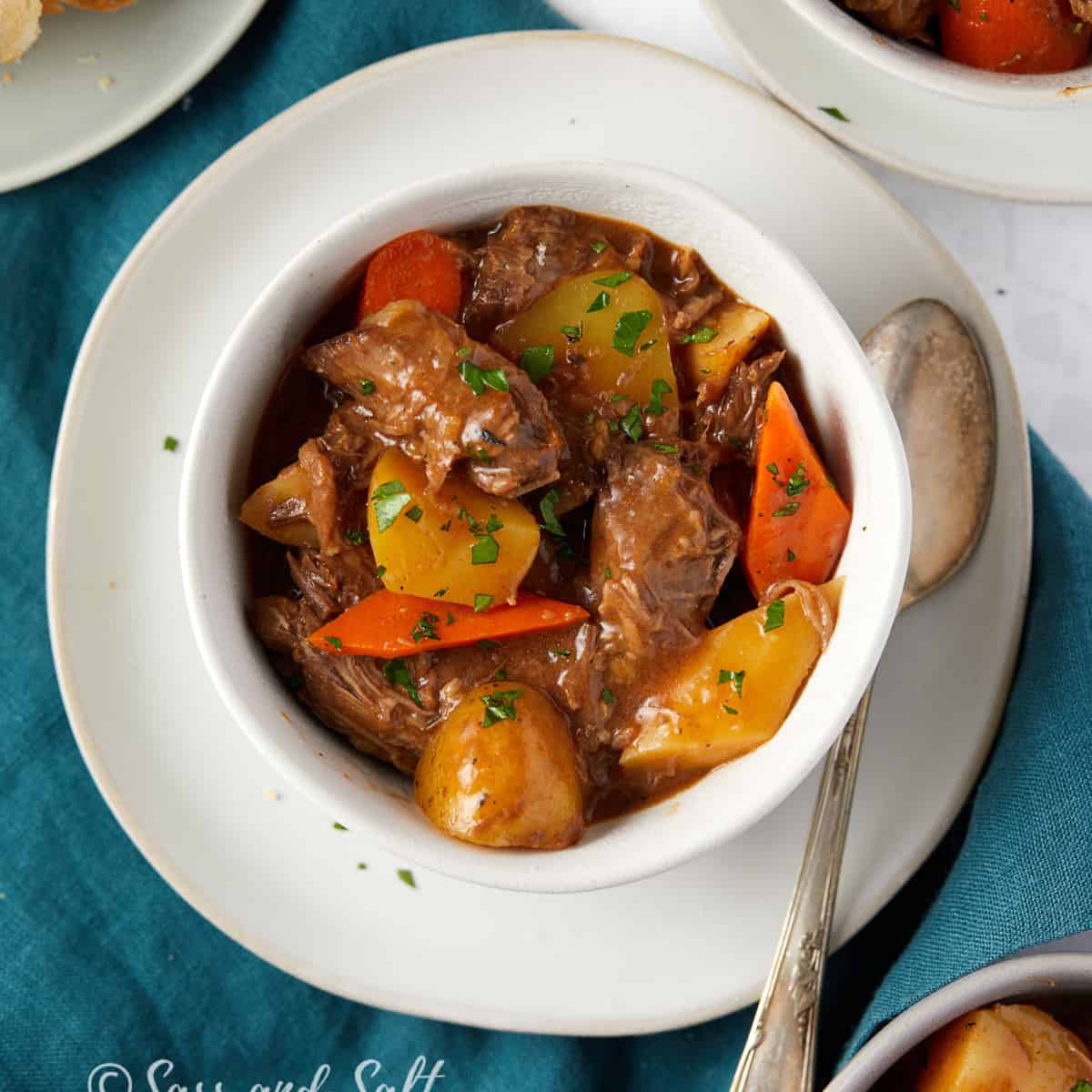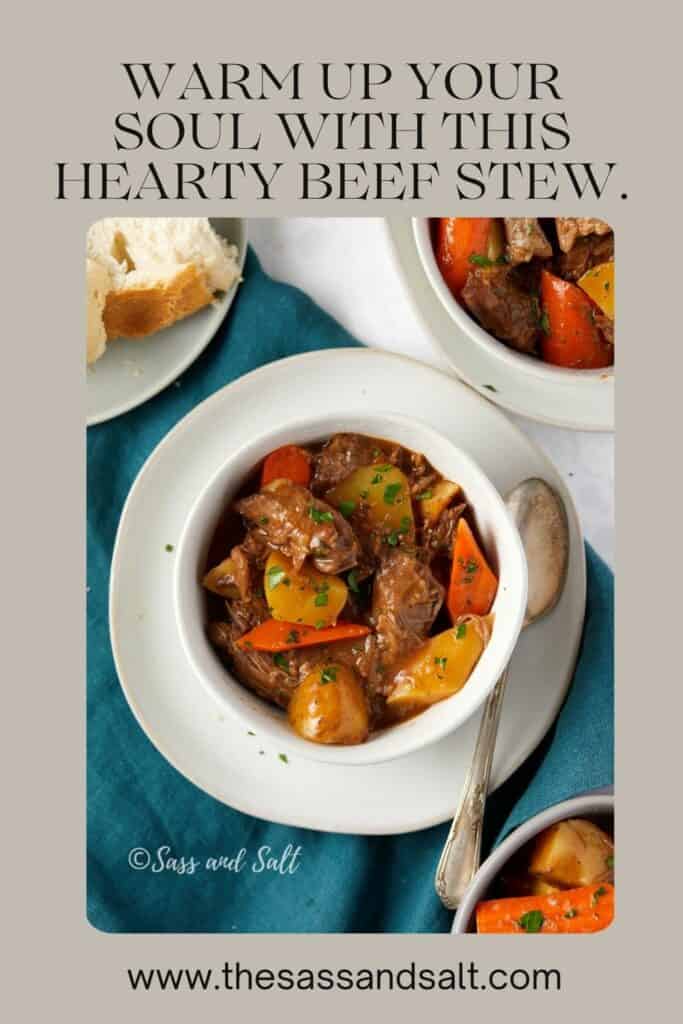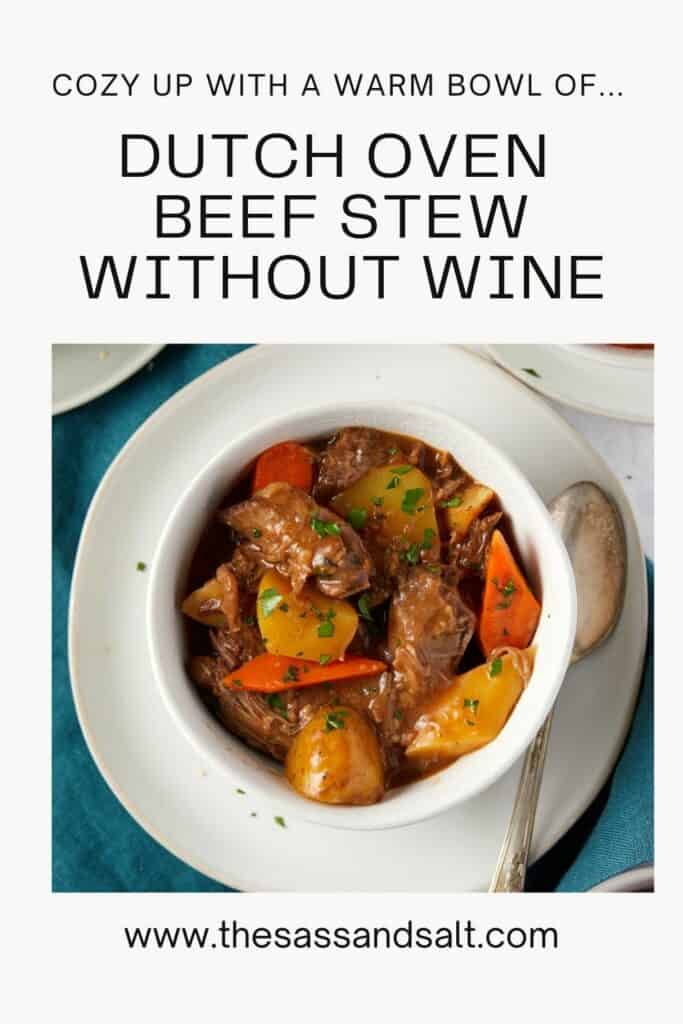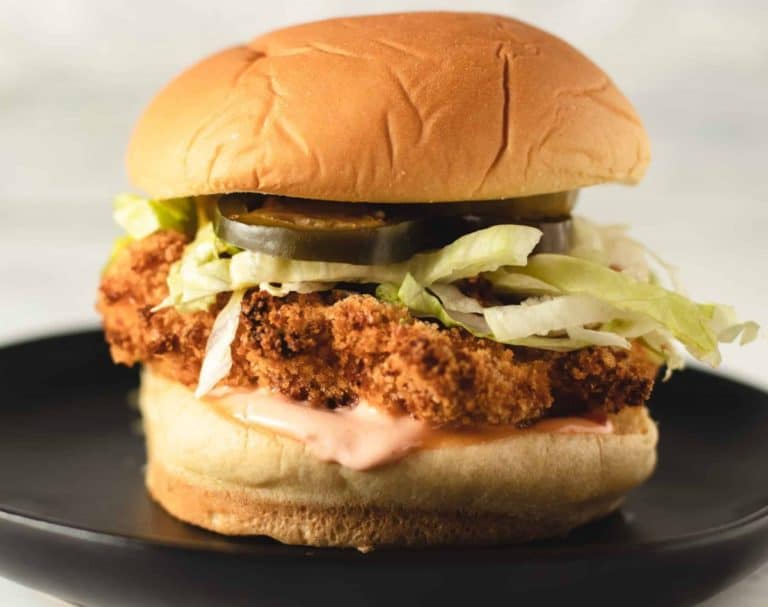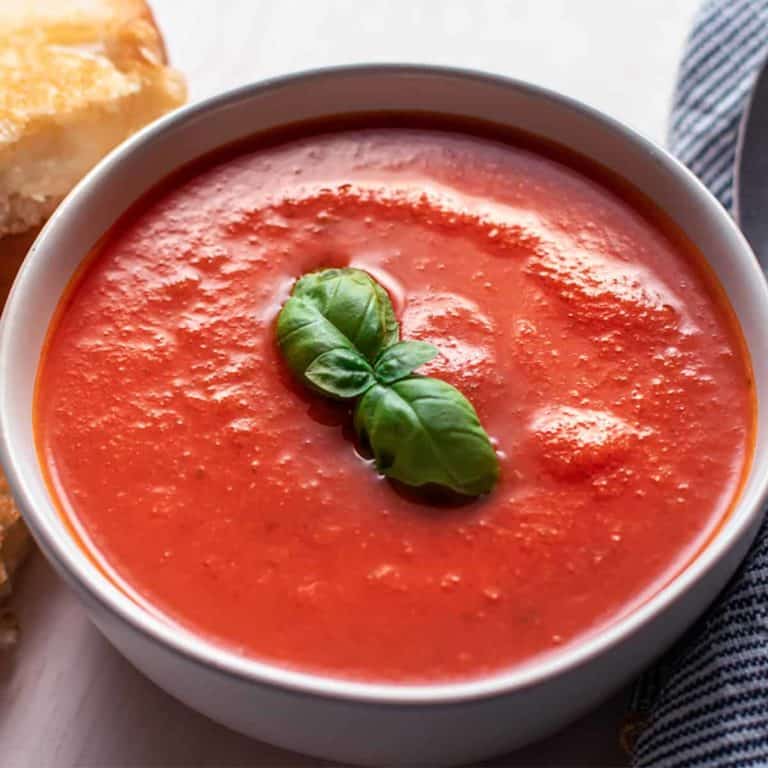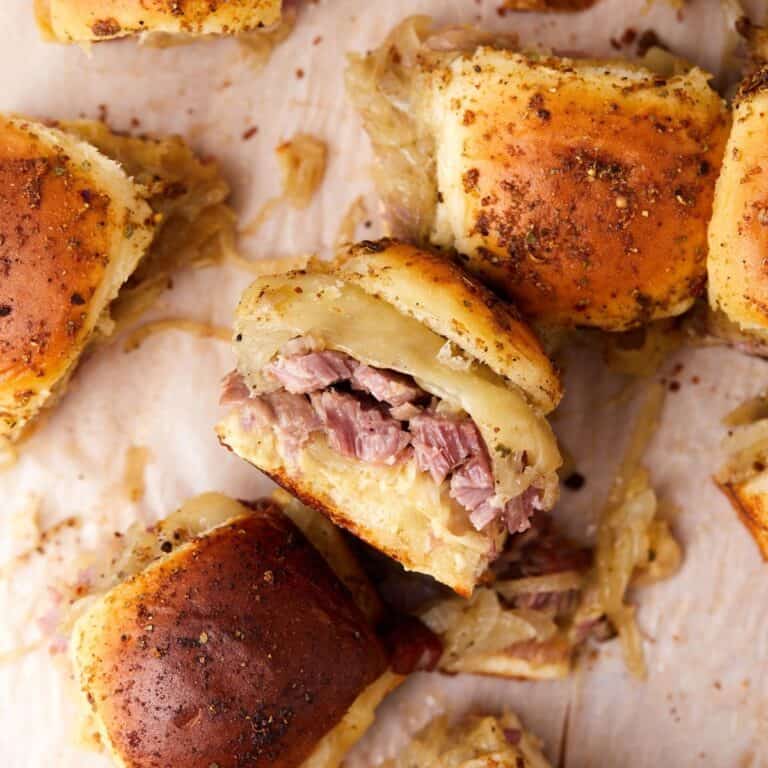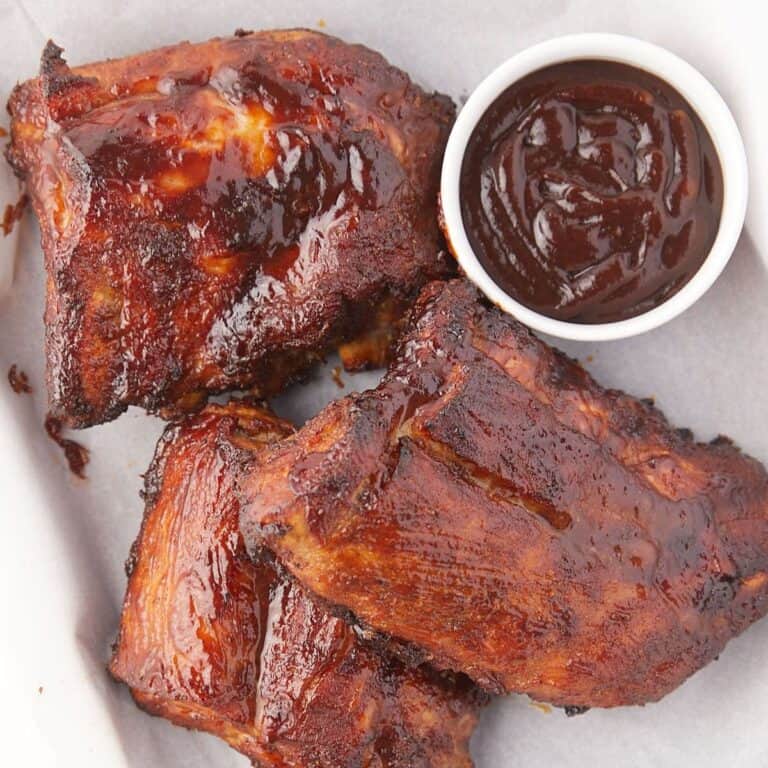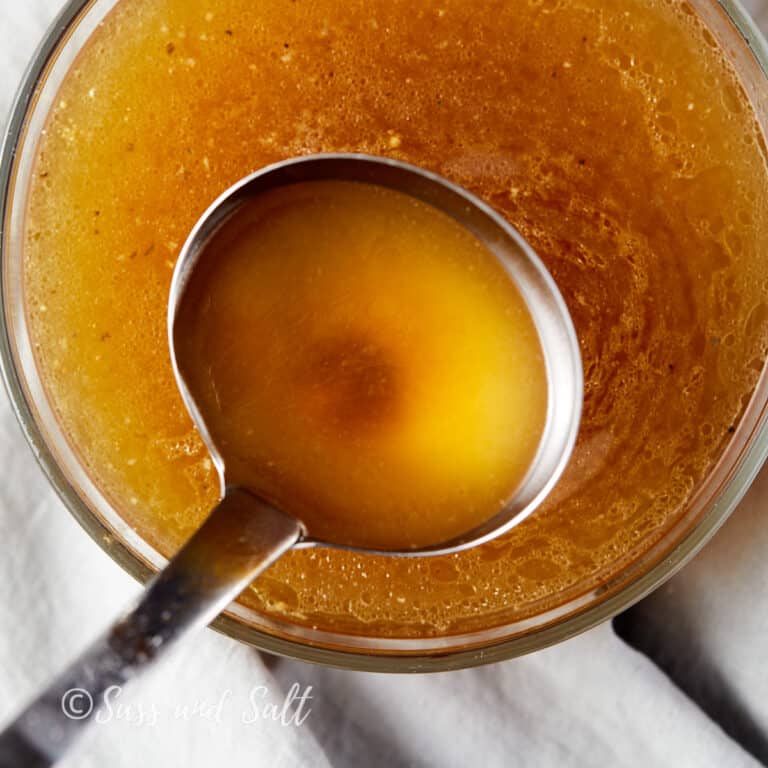This Dutch Oven Beef Stew without wine presents a comforting dish for those in search of deep, hearty flavors. A whole piece of beef simmers alongside robust potatoes and sweet carrots, creating a rich, savory broth. Seasoned impeccably and brought to the perfect thickness, this stew offers a warming comfort that soothes from the inside out.
For a bowlful of comforting flavors, try Roasted Tomato Soup with Basil and Creamy Mushroom Orzo Soup.
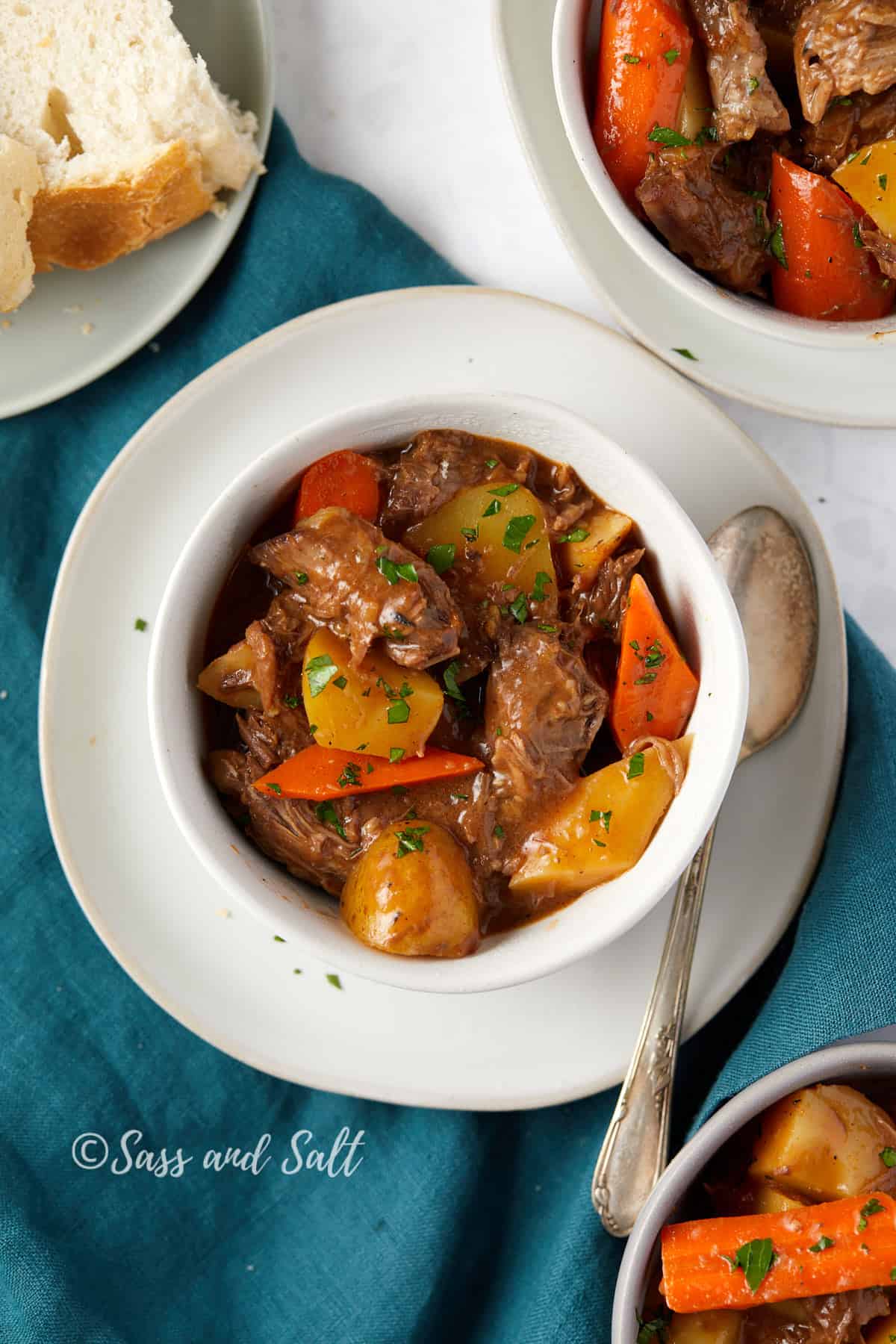
Save this Recipe!
Why You’ll Love this Dutch Oven Beef Stew without Wine
- Deep, Rich Flavor: Slow cooking in a Dutch oven allows the flavors to deepen and blend, creating a rich and satisfying stew.
- Hearty and Filling: Packed with tender beef chuck roast and a variety of vegetables, this stew is a complete meal that will keep you full and content.
- No Wine Needed: Ideal for those who prefer cooking without alcohol, this recipe maintains its robust flavor without the use of wine.
- Versatile: Feel free to tweak the recipe to include your favorite vegetables or whatever you have on hand.
- Great for Leftovers: This stew tastes even better the next day, making it perfect for meal prep or enjoying leftovers.
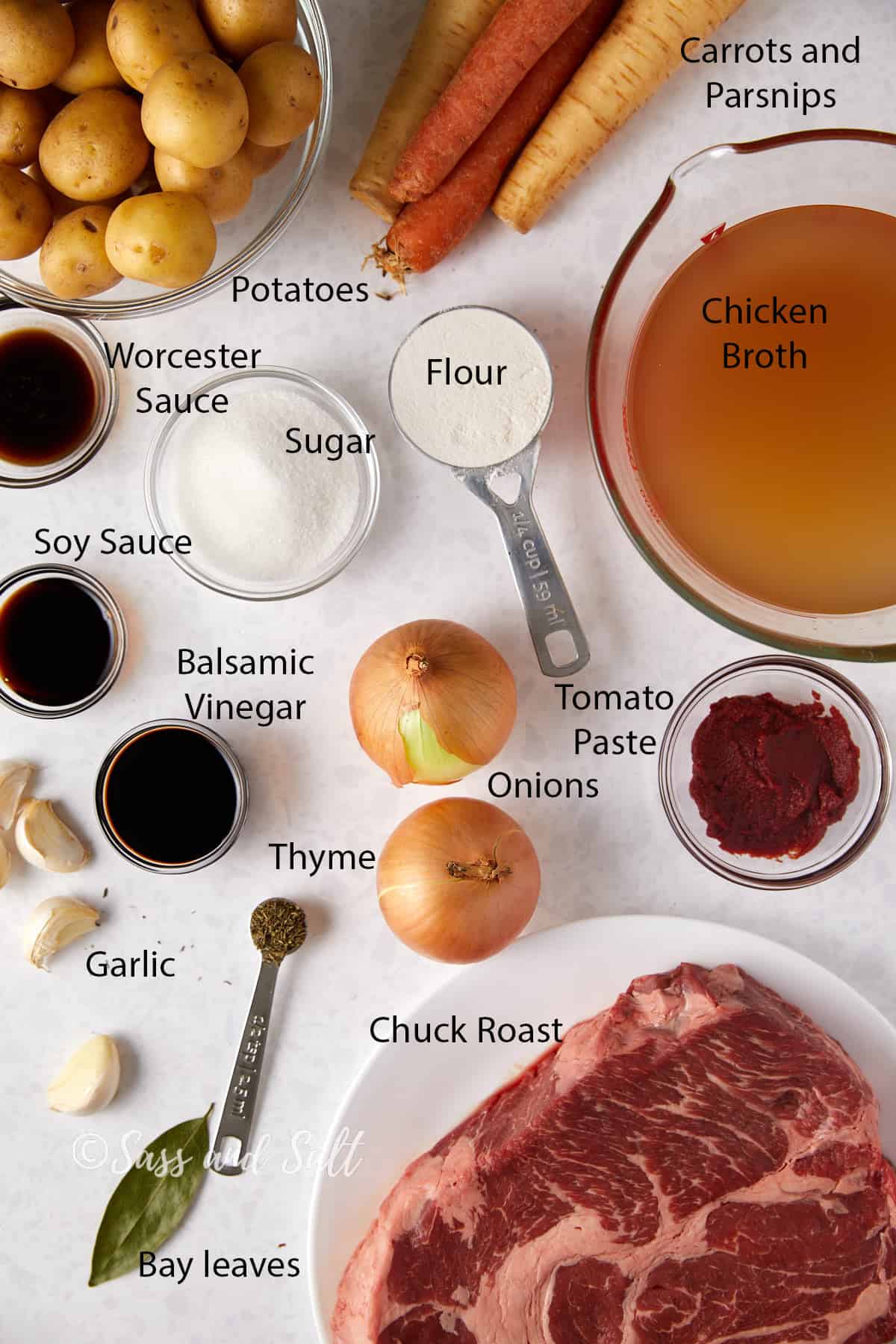
Ingredients for Beef Stew
These ingredients work together to create a flavorful and aromatic beef stew that’s satisfying and full-bodied, even without the traditional addition of wine.
- Chuck Roast: A cut of beef from the shoulder that’s rich in flavor and becomes tender when slow-cooked, making it the perfect choice for stews. Choosing the ideal meat cut is crucial for your dish. Opt for a chuck roast with ample marbling, which refers to the white fat veins throughout the meat. This will ensure tenderness and flavor. It’s best to avoid pre-packaged cuts labeled as “stew meat,” particularly those that appear lean, as they often don’t soften as desired, despite lengthy cooking.
- Potatoes: They add heartiness to the stew and thicken the broth as they break down slightly during cooking. I used baby yellow potatoes cut in half. If you can’t find those, use Yukon gold or white potatoes, peeled and cubed.
- Carrots and Parsnips: These root vegetables contribute sweetness and earthiness, as well as vitamins and color to the dish. I love the flavor that parsnips add to this stew, but if you don’t want to use parsnips, just use all carrots.
- Chicken Broth: Used as a base for the stew, it adds depth and complements the beef flavor, especially in the absence of wine. Unless preparing beef broth yourself using bones, meat, and veggies, it’s generally better to use store-bought or homemade chicken broth. This is because commercially available beef stock contains more flavor-enhancing additives than genuine beef ingredients.
- All-purpose flour: Flour is used to thicken the stew.
- Sugar: A little sugar can balance the flavors, adding a slight sweetness that enhances the overall taste profile.
- Worcester Sauce: This is a fermented condiment that brings a complex, umami flavor that can substitute for the depth often provided by wine.
- Soy Sauce: Adds saltiness and depth of flavor, contributing to the savory taste of the stew.
- Balsamic Vinegar: Provides acidity and a touch of sweetness, and can be used to deglaze the pot after browning the meat, similar to wine.
- Onions: A foundational ingredient that offers sweetness and aromatics to the stew, contributing to the base of the flavor profile.
- Tomato Paste: Gives the stew a rich tomato flavor and color, and it also helps to thicken the stew.
- Garlic: Adds an essential aromatic that infuses the stew with a distinctive flavor.
- Thyme: This herb contributes a subtle earthy and lemony note that complements the beef and vegetables.
- Bay Leaves: These leaves add a layer of flavor complexity with their herbal and slightly floral notes.
How to make Beef Stew without Wine
Prepare the Oven & Beef: Preheat your oven, season the beef with salt and pepper, and brown it in a hot, oiled Dutch oven. This step adds depth and dimension to the stew. Unlike most recipes, I don’t cut up the beef into pieces just because I don’t love cutting up raw meat. I shred it after it is braised and tender. If you don’t have a big enough Dutch oven, you may need to cut the beef into pieces first. See recipe card notes for instructions.
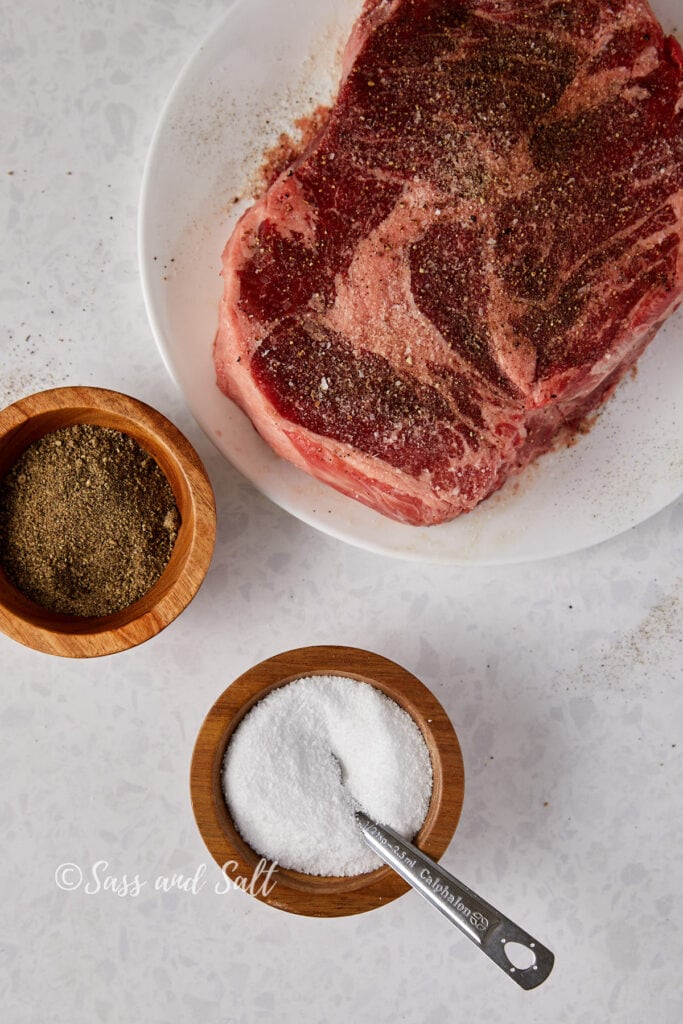
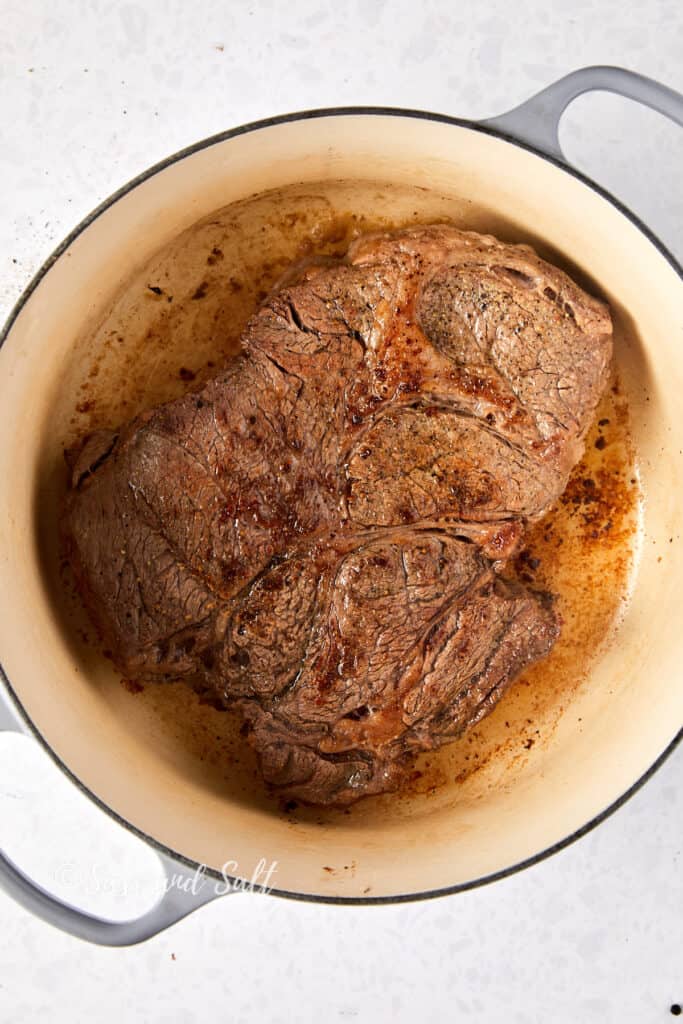
Sauté Aromatics: Remove the beef, then cook onions and garlic until softened, adding balsamic vinegar to deglaze the pan. Add soy sauce, Worcestershire sauce, tomato paste, and stir well.
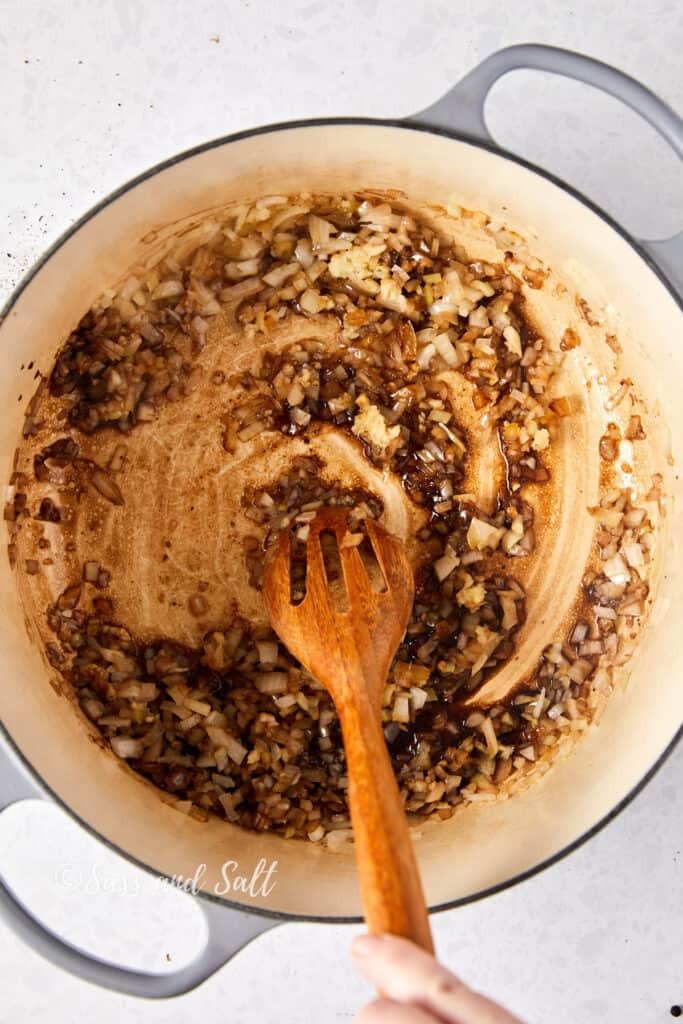
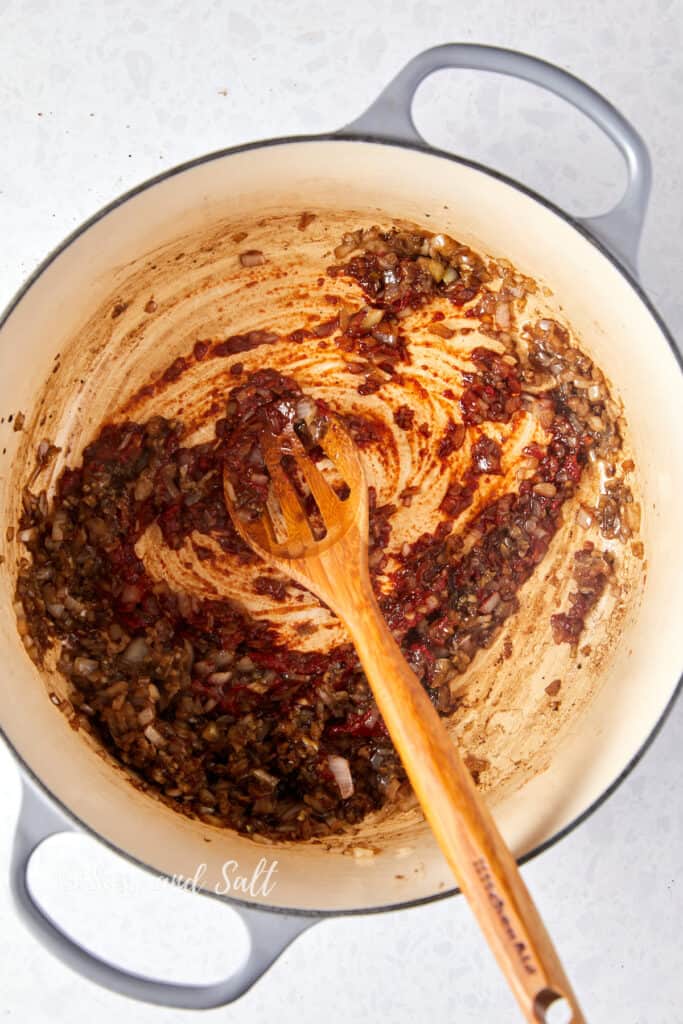
Incorporate Thickener and Aromatics: Dust the flour over the pot and cook it briefly to remove the raw taste. Then pour in the chicken broth, water, bay leaf, thyme, and sugar, combining everything with a good stir. Return the beef to the pot.
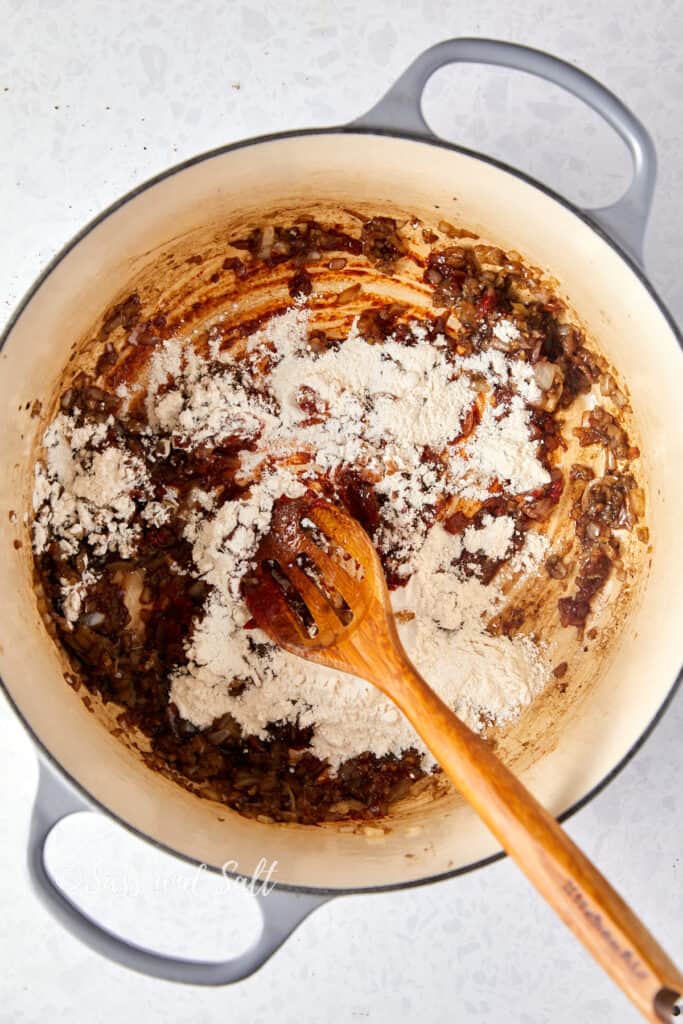
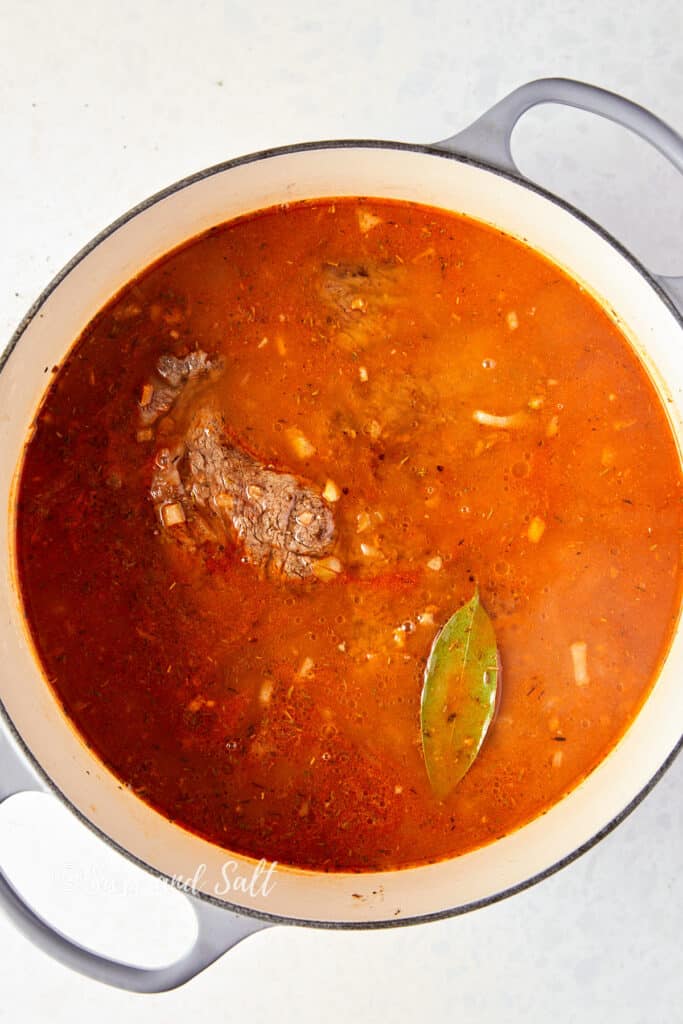
Slow Cook: Cover the pot and place it in the oven, braising until the beef is almost tender.
Add Vegetables: Add carrots, parsnips, and potatoes, and continue to cook until everything is tender.
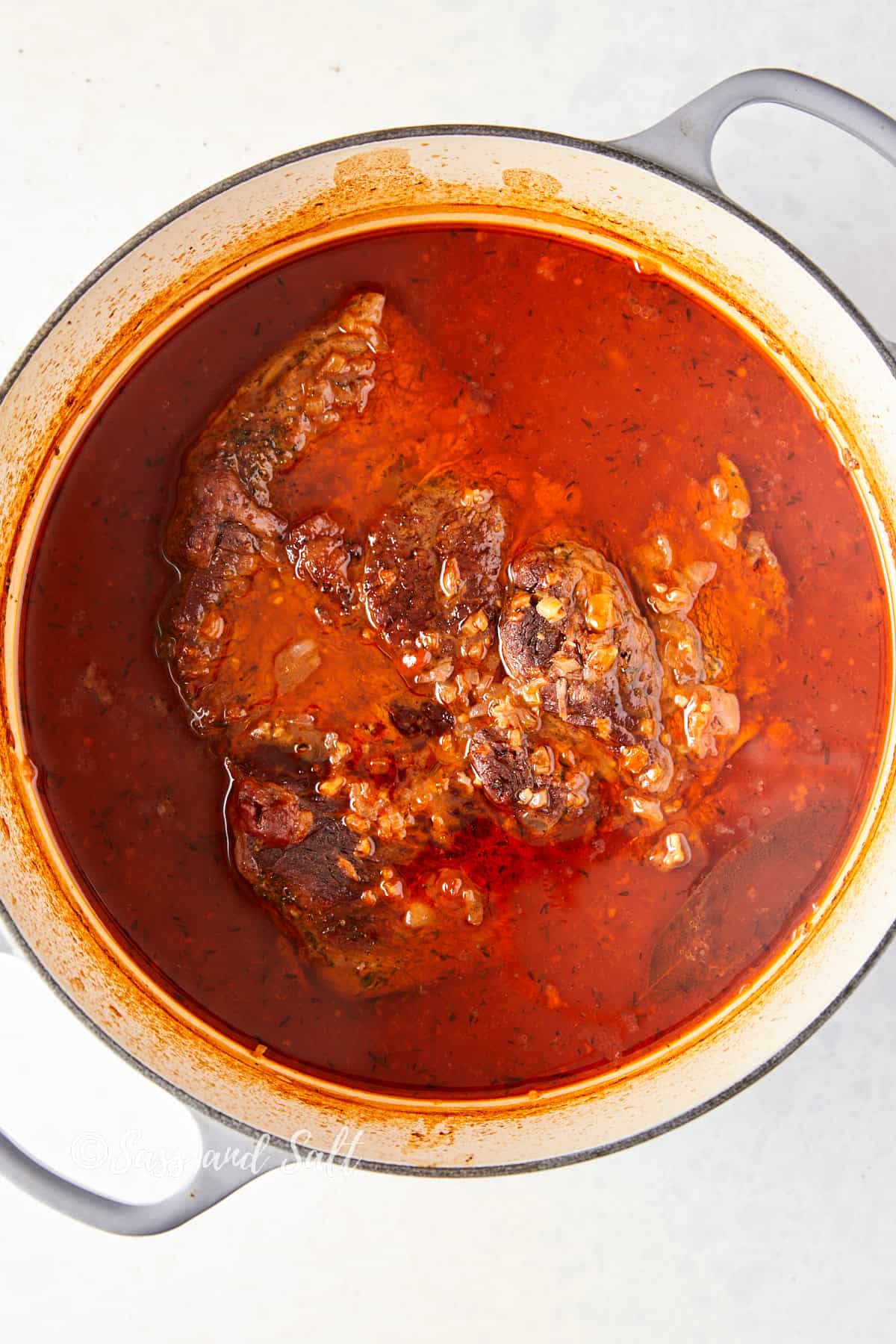
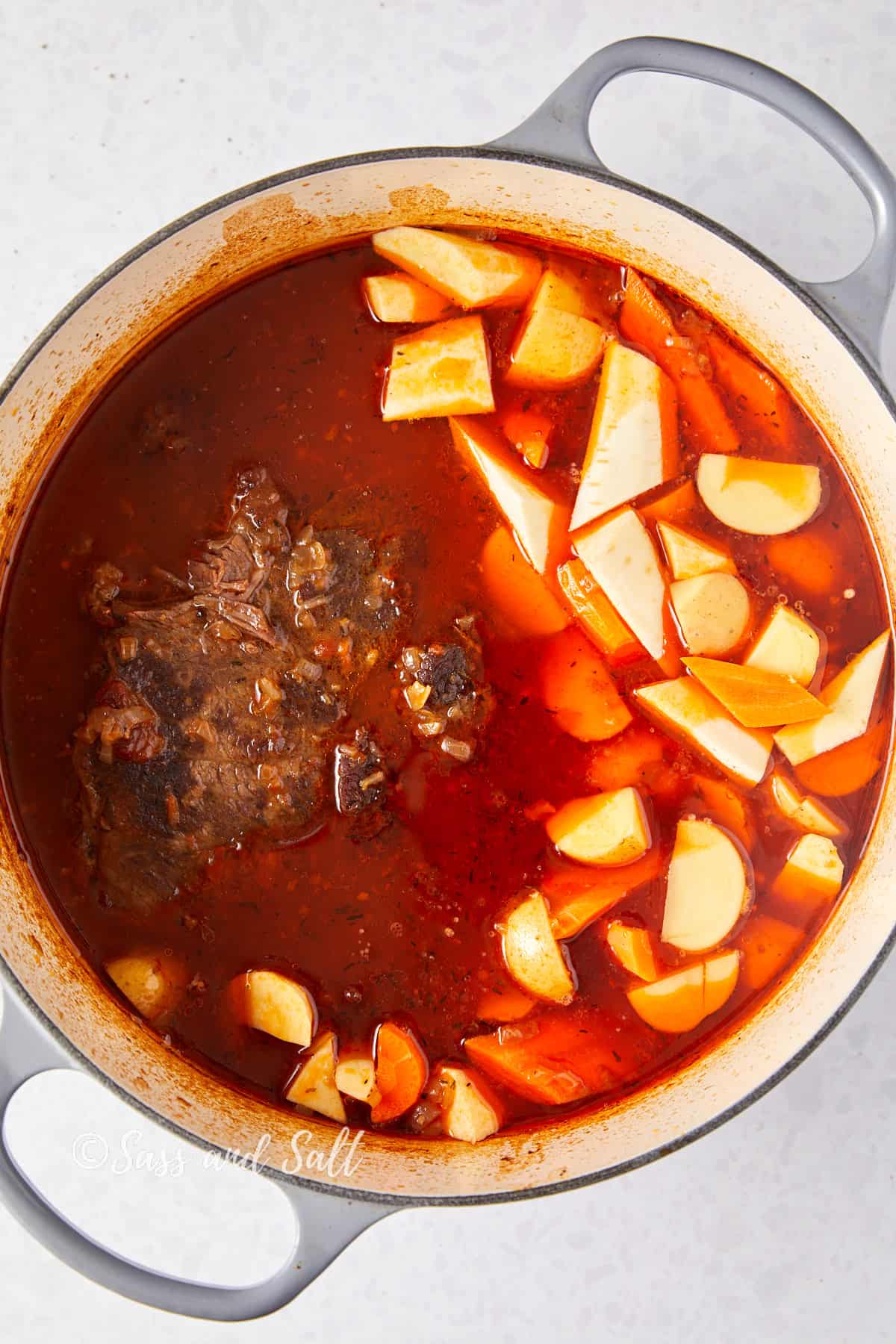
Remove Beef & Shred: Once the meat is cooked place it on a sturdy cutting board. Use two forks to pull the meat apart into thin strands, going against the grain for easier shredding. Remove any pockets of fat while shredding. Skim the pot of any fat that rises to the top.
Return shredded beef to the pot and mix thoroughly. Heat thoroughly on the stovetop if needed. Enjoy!
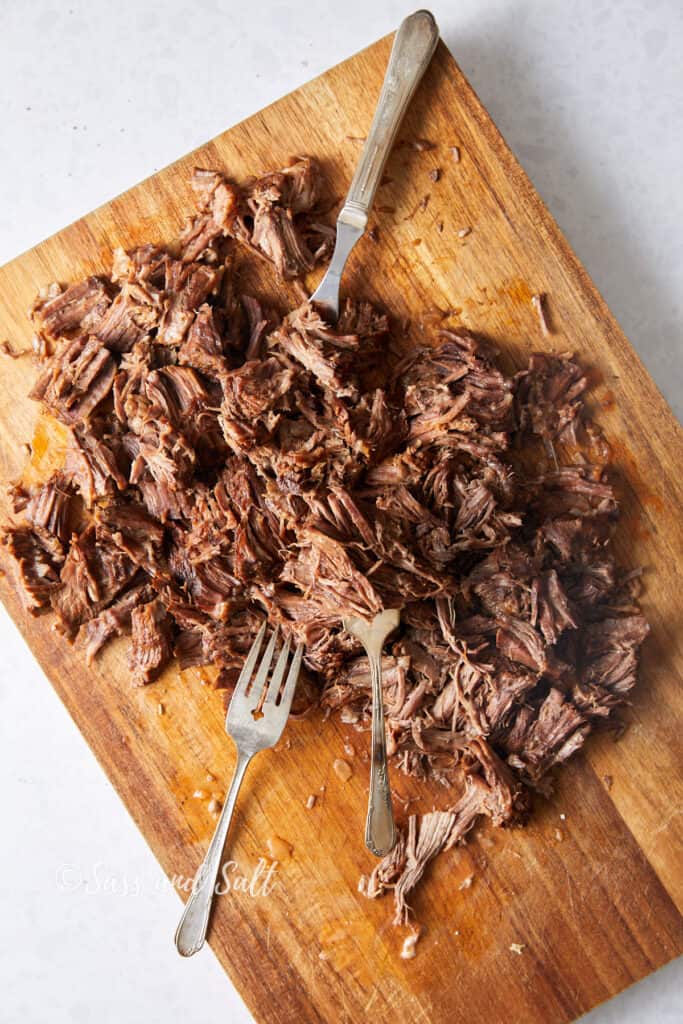
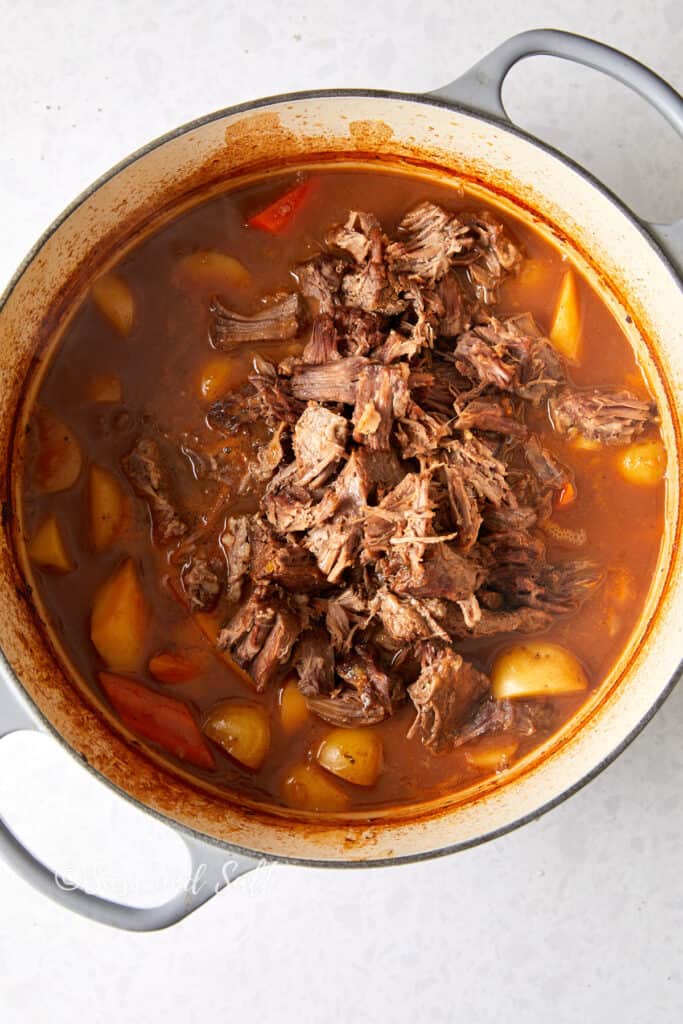
Recipe Tips and Tricks
- Thin Stew: If the stew is too thin, mix a tablespoon of cornstarch with cold water and stir it into the stew. Simmer until thickened.
- Thick Stew: For stew that’s too thick, gradually stir in more broth until you reach the desired consistency.
- Watch Your Meat: Don’t Overcook It! Cooking beef stew requires careful attention to avoid overcooking. While it’s tempting to let the stew simmer for hours, thinking it will become more tender, this is not the case. The process of stewing involves two competing factors: converting connective tissues into gelatin, which makes the meat tender and moist, and the contraction of muscle proteins, which can expel moisture and make the meat tough. The goal is to cook the stew just long enough for the connective tissues to soften without losing too much natural juice from the muscle proteins. Typically, a 3 lb piece of chuck roast will be tender in about 2 1/2 hours. It’s crucial to start checking the meat after around 2 1/4 hours and stop cooking when it’s just tender enough.
What to serve with beef stew
For a hearty beef stew, traditional and comforting side dishes often work best. Consider:
- Crusty Bread: My mom always served Pumpernickel bread, which, to me, is the perfect pairing. A fresh baguette or slices of sourdough would also be a great pick to sop up the rich stew juices.
- Mashed Potatoes: Creamy mashed potatoes make for a classic pairing with stew.
- Steamed Green Beans: Lightly steamed or sautéed green beans can add a crisp, fresh contrast.
- Buttered Egg noodles: buttered egg noodles for a delightful twist that adds a silky, comforting texture, perfectly complementing the rich and hearty flavors of the stew.
- Polenta: Creamy polenta is another great option for soaking up the stew’s flavors.
- Rice: A simple side of white or brown rice can be an ideal bed for the stew.
Recipe Variation for Beef Stew without Wine
This beef stew recipe without wine is flexible, and you can customize it to your taste preferences. You can omit the potatoes for a different texture and lay the stew over a bed of buttered egg noodles. Or, for added color and variety, stir in some bright green peas or richly browned mushrooms just before serving. Whichever way you adapt, this beef stew recipe remains a comforting and warming meal for chilly evenings.
Meat Variations:
- Lamb: Substitute beef with lamb for a richer flavor.
- Chicken: Use bone-in chicken thighs for a lighter but flavorful stew.
- Pork: For a different twist to beef stew recipe without wine, try pork shoulder cut into chunks.
Vegetable Variations:
- Root Vegetables: Add turnips, parsnips, or sweet potatoes for sweetness and heartiness.
- Leafy Greens: Stir in kale or spinach at the end for a nutrient boost.
- Legumes: Incorporate lentils or beans for additional protein and fiber.
Dutch Oven Beef Stew without wine Substitutions
- Beef: If chuck roast isn’t available, you can use brisket or round cuts, although cooking times may vary.
- Potatoes: Swap out for turnips, cauliflower, or even radishes for a lower-carb option.
- Carrots: Parsnips or sweet potatoes can be a sweet alternative.
- Broth: Vegetable broth can be used instead of chicken broth for a lighter flavor.
- Herbs: For a classic beef stew, if you would prefer fresh herbs, fresh herbs can be used at a ratio of 3:1 (3 part fresh to 1 part dried).
Storage TIPS
- Cooling: Instead of leaving large quantities of food, like a big pot of soup, to cool in one container, it’s better to distribute it into multiple shallow containers. This method speeds up the cooling process, minimizing the time bacteria can proliferate and reducing the chances of foodborne illnesses.
- Refrigeration: Store in an airtight container and refrigerate; it usually keeps well for 3 to 4 days.
- Freezing: Freeze in portions for convenience. Use freezer-safe bags or containers, and it can last up to 3 months.
- Reheating: Thaw overnight in the fridge if frozen and reheat on the stove or microwave. Ensure it’s heated through to at least 165°F (74°C) before serving. Add some chicken broth to loosen if necessary.
- Avoid Repeated Reheating: Reheat only what you’ll be eating at that time to maintain quality and safety.
FAQ’s
Using a broth, like beef, chicken, or vegetable, is an excellent substitute for wine. It adds moisture and complements the flavor of your stew. For an extra kick, consider adding a tablespoon of vinegar or lemon juice to the broth to replicate the acidity of wine.
Red wine is not strictly necessary in beef stew but is often used for its rich, robust flavor. I
Tomato paste adds a rich, savory flavor to beef stew. It contains natural sugars that caramelize during cooking, intensifying the stew’s overall flavor. The umami taste from tomato paste complements the savory beef and vegetables, creating a more complex flavor profile.
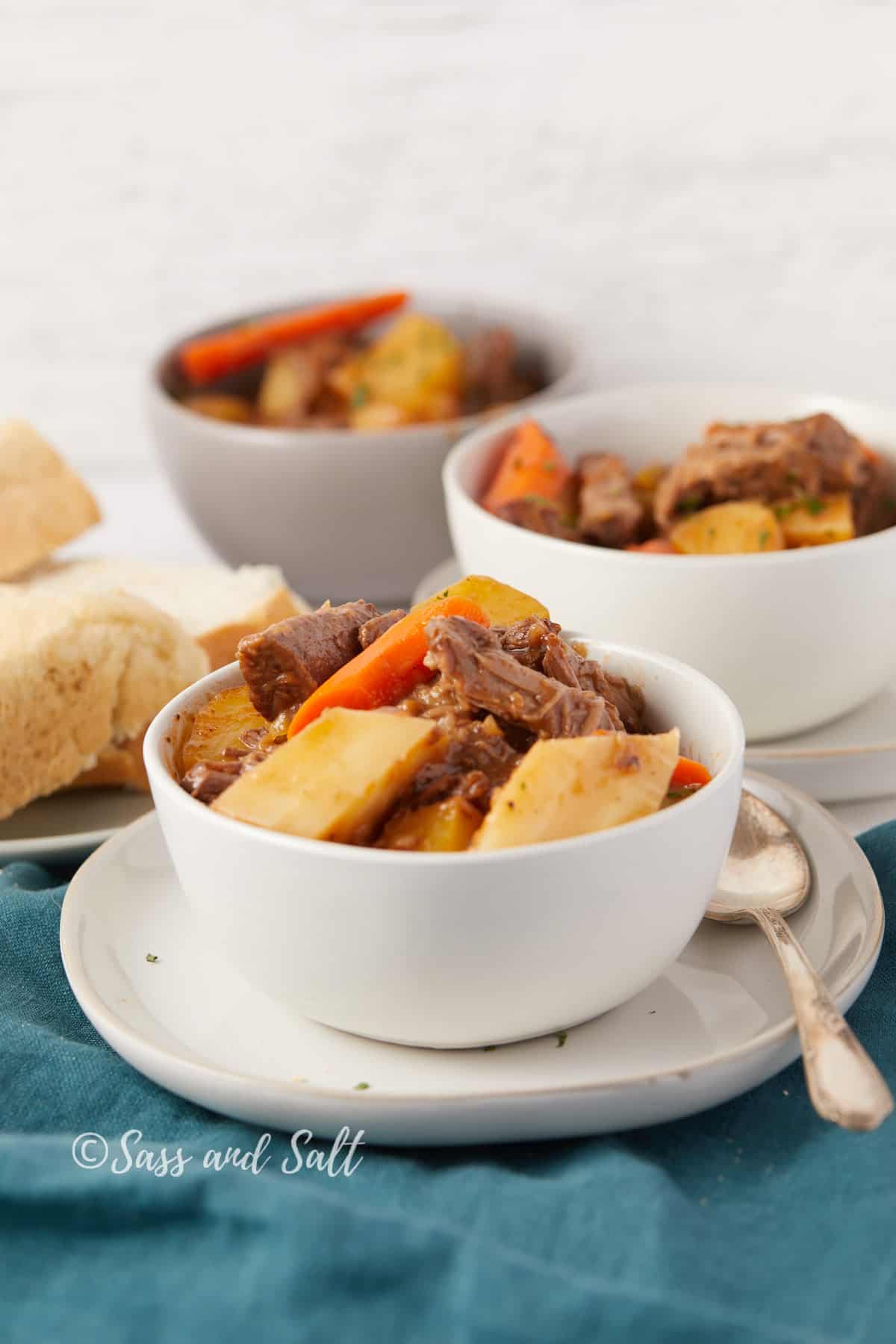
Let me know if you try this Dutch Oven Beef Stew without wine. Leave a comment, and if your family loves it as much as mine, give it a five-star ⭐️ rating! Join our mailing list to receive more delicious recipes delivered to your inbox.
Dutch Oven Beef Stew without Wine
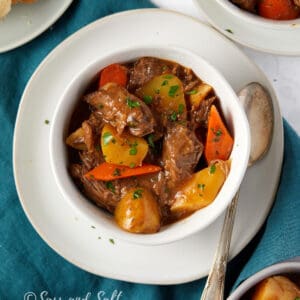
Equipment
Ingredients
- 3 pounds boneless Beef Chuck Roast well-marbled
- 2 teaspoons kosher salt
- 1 teaspoon freshly ground black pepper
- 2 tablespoons olive oil
- 2 cups chopped yellow onions (2 onions)
- 2 tablespoons minced garlic (6 cloves)
- 2 tablespoons balsamic vinegar
- 1 tablespoon soy sauce
- 1 tablespoon Worcestershire sauce
- 1 ½ tablespoons tomato paste
- ¼ cup all-purpose flour
- 5 cups low sodium chicken broth, store-bought or homemade
- 1 cup water
- 1 bay leaf
- ½ teaspoon dried thyme
- 1½ teaspoons sugar
- 4 large carrots cut into 1-inch chunks on a diagonal
- 2 parsnips cut into 1-inch chunks on a diagonal
- 1 pound baby yellow potatoes, cut in half
Instructions
- Preheat the oven to 325°F and set a rack in the lower middle position.
- Pat the beef dry and season with salt and pepper. In a large Dutch oven or heavy soup pot, heat 2 tablespoons of olive oil over medium-high heat until shimmering.
- Add beef to the Dutch oven. Cook, turning occasionally, until meat is well browned on 2 sides, about 10 minutes. Transfer beef to a rimmed baking sheet or large plate and set aside. (To sear the meat properly, let the meat develop a nice brown crust before turning with tongs.) Transfer the beef to a large plate and set aside.
- Add the onions, garlic, balsamic vinegar, soy sauce, and Worcester sauce; cook, stirring with a wooden spoon and scraping the brown bits from the bottom of the pan, for about 5 minutes. Add the tomato paste and cook for a minute more. Sprinkle with the flour. Stir until the flour is dissolved, 1 to 2 minutes.
- Add the beef with its juices back to the pan. Add the chicken broth, water, bay leaf, thyme, and sugar. Stir with a wooden spoon to loosen any brown bits from the bottom of the pan, and bring to a boil. Cover the pot with a lid, transfer to the preheated oven, and braise for 2 hours 20 minutes.
- Remove the pot from the oven and add the carrots, parsnips, and potatoes. Cover and place back in oven for about 40 minutes more, or until the vegetables are cooked, the broth is thickened, and the meat is tender.
- Remove beef from the broth and place it on a cutting board. Use forks, shred beef, and remove any big chunks of fat. Add shredded beef back into broth
- Fish out the bay leaf and discard, then taste and adjust seasoning, if necessary. Add the shredded beef back into the pot and carefully stir in with the broth and vegetables.
- Serve the stew warm, or let it come to room temperature, and then store in the refrigerator overnight or until ready to serve. Reheat, cover, and cook over medium heat. Garnish your classic beef stew with fresh parsley, if desired.
Notes
- If you do not have a big enough Dutch oven to sear the whole piece of meat (the one shown in the blog post is a 7.25 quart). You can cut the beef into pieces, season with salt and pepper, and sear them in batches. Then, follow the recipe as written.
- Also, if you prefer, you could also sear the whole piece of beef and then cut it into chunks. Then, follow the recipe as written.
- If you don’t have a Dutch oven or covered pot that is appropriate for the oven, the stew can be cooked on the stove. The timing will be the same and it should be cooked over the lowest setting.

